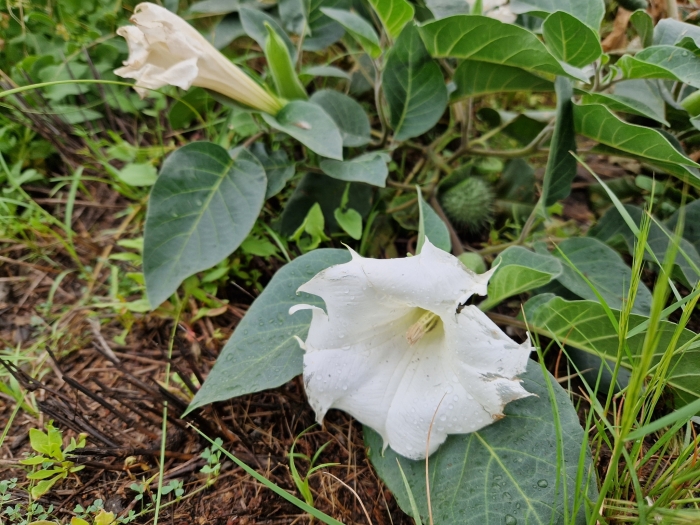Pricklyburr
(Datura innoxia)
Pricklyburr (Datura innoxia)
/
/

Jens-Christian Svenning
CC BY 4.0
Image By:
Jens-Christian Svenning
Recorded By:
Copyright:
CC BY 4.0
Copyright Notice:
Photo by: Jens-Christian Svenning | License Type: CC BY 4.0 | License URL: http://creativecommons.org/licenses/by/4.0/ | Rights Holder: Jens-Christian Svenning | Publisher: iNaturalist | Date Created: 2022-12-26T12:36:13-08:00 |





















Estimated Native Range
Summary
Datura innoxia, commonly known as pricklyburr or moonflower, is a tuberous-rooted subshrub native to open woodlands and desert scrub of the Southwestern United States, Mexico, Central and South America. It is also found in disturbed areas, indicating its adaptability to various environments. This plant typically reaches 2 to 5 feet in height and is covered with grayish hairs on its stems and leaves. The leaves emit a foul odor when crushed. The large, white, trumpet-shaped flowers are 5-7 inches long and bloom from early summer until late fall, opening at night and emitting a pleasant fragrance to attract pollinators. The flowers are followed by spiny egg-shaped capsules that contain numerous seeds. Moonflower is known for its striking nocturnal blooms and is often used in night gardens or as an ornamental plant in containers.
Moonflower is appreciated for its showy, fragrant flowers and is relatively easy to maintain. It requires full sun to part shade, well-drained soil, and moderate watering, with reduced water in winter. While it can be grown as an annual in temperate regions, it is perennial in warmer climates. It is not commonly used for culinary or medicinal purposes due to its toxic properties. Gardeners should be cautious, as all parts of the plant are poisonous if ingested. It can be potentially invasive in some regions, so it is crucial to check local regulations before planting.CC BY-SA 4.0
Moonflower is appreciated for its showy, fragrant flowers and is relatively easy to maintain. It requires full sun to part shade, well-drained soil, and moderate watering, with reduced water in winter. While it can be grown as an annual in temperate regions, it is perennial in warmer climates. It is not commonly used for culinary or medicinal purposes due to its toxic properties. Gardeners should be cautious, as all parts of the plant are poisonous if ingested. It can be potentially invasive in some regions, so it is crucial to check local regulations before planting.CC BY-SA 4.0
Plant Description
- Plant Type: Shrub, Herb
- Height: 2-3 feet
- Width: 3-6 feet
- Growth Rate: Moderate, Rapid
- Flower Color: White
- Flowering Season: Spring, Summer, Fall
- Leaf Retention: Semi-deciduous
Growth Requirements
- Sun: Full Sun
- Water: Medium
- Drainage: Medium
Common Uses
Border Plant, Fragrant, Potted Plant, Showy Flowers
Natural Habitat
native to open woodlands and desert scrub of the Southwestern United States, Mexico, Central and South America
Other Names
Common Names: Thorn Apple, Angel Trumpet, Campana Blanca, Campana Del Pasto, Chamisco Blanco, Desert Thornapple, Sacred Datura, Moonflower
Scientific Names: , Datura innoxia, Datura guayaquilensis, Datura innoxia var. innoxia, Datura inoxia subsp. inoxia, Datura metel, Datura metel, Datura metel, Datura meteloides, Datura meteloides
GBIF Accepted Name: